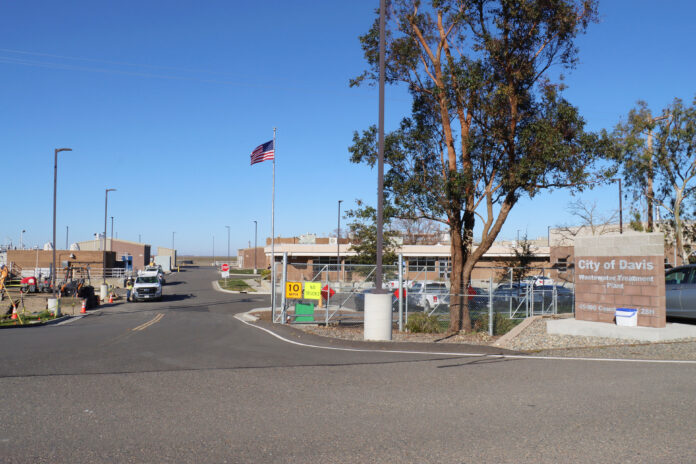Wastewater-based disease surveillance contributes to greater health equity and is essential for monitoring viruses
By LA RISSA VASQUEZ — city@theaggie.org
Throughout January, COVID-19 levels have fluctuated, but are significantly higher in Davis than in other parts of Yolo County, according to wastewater monitoring in the city of Davis and UC Davis wastewater plants by Healthy Central Valley Together.
Dr. Heather Bischel, project lead for wastewater monitoring for Healthy Davis Together and assistant professor at UC Davis Department of Civil and Environmental Engineering, explained how wastewater can reveal COVID data.
“Wastewater has a lot of different pathogens present in [it] that people excrete if they’re infected,” Bischel said. “The virus itself can be measured in wastewater [and] Wastewater SCAN is this large program that is now established where the city of Davis and UC Davis are participants in.”
Wastewater SCAN is a national wastewater monitoring project from Stanford University that has been rapidly expanding over the past six months as many different groups across the nation begin to launch their own wastewater monitoring projects since the pandemic.
Healthy Central Valley, an offshoot of the Healthy Davis Together campaign, highlighted the need for monitoring in the central valley long before Wastewater SCAN was established. In an email, Dr. Colleen Naughton, assistant professor of Civil and Environmental Engineering at UC Merced and wastewater monitoring project co-lead with Bischel, talked about the organization’s goals.
“We had seen that there was a lack of wastewater monitoring for SARS-CoV-2 throughout the Central Valley compared to urban and coastal California and wanted to see expansion of this public health tool for greater health equity,” Naughton said.
Wastewater-based disease surveillance contributes to greater health equity due to its cost-effective and unbiased testing of samples representative of an entire community, according to Dr. Bischel.
“After you’ve had a rising infection of [COVID-19], you’d expect the concentrations to go up during those relative surges, to see different signals for different viruses, and then they evaluate the wastewater against clinical information,” Bischel said. “What we monitor in the wastewater does correlate with what we know about transmission and infections, and that makes the wastewater data really useful for public health because then you can get an idea of the changes in terms of infections for these different targets.”
Different targets include other respiratory viruses such as RSV, influenza and other coronaviruses including variants of the SARS-COV-2 virus that causes COVID-19. Bischel talked about how wastewater can measure other viruses.
“In addition to measuring the total amount of [COVID-19], we’re also able to target some specific variants and to measure the concentrations of different variants. [The Omicron variant] may be a bit more challenging [because] it’s the combination of recombinant variants that has genetic components from different variants,” Bischel said. “The data that we’re looking at for the city of Davis and UC Davis campus was focused on that kind of total amount of [COVID-19] present, and understanding trends as they go up and down through time, and then we have some additional information on variants that can help complement [and] inform our understanding of new variants [as they] come through. How one [variant] is taking over relative to another.”
Naughton explained why variants such as the Omicron subvariant, XBB.1.5, are still a challenge even in a largely vaccinated community like Davis.
“The City of Davis may have a high full — two doses — vaccination rate, but much of the country has not gotten their booster doses, especially the new bivalent boosters that are more effective against the current variants,” Naughton said. “Also, the current variants are very transmissible and many of our prior precautions, like indoor masking, reduced travel, etc, have been lifted and people are mixing more and more likely to spread and catch the virus. The vaccines are still effective at reducing hospitalizations and deaths, but you still can catch COVID-19 and have mild symptoms.”
The Davis community’s best defense continues to be wearing well-fitting N95 or KN95 masks in crowded indoor spaces, staying home when feeling sick, being up to date on COVID-19 vaccinations and boosters, testing for COVID-19 before events or travel and washing hands with soap and water, according to Naughton.
“We may be tired of the pandemic and the virus, but it is not tired of us. We must still follow public health guidance,” Naughton said. “That doesn’t mean we can’t go about our lives, seeing loved ones and eating at restaurants but we can reduce our exposure when we can by wearing face coverings in crowded indoor settings and staying up to date on vaccinations. […]. With an expansion of rapid tests that are not reported to the health departments, wastewater is a reliable indicator of the level of infection in the community.”
Written by: La Rissa Vasquez — city@theaggie.org





